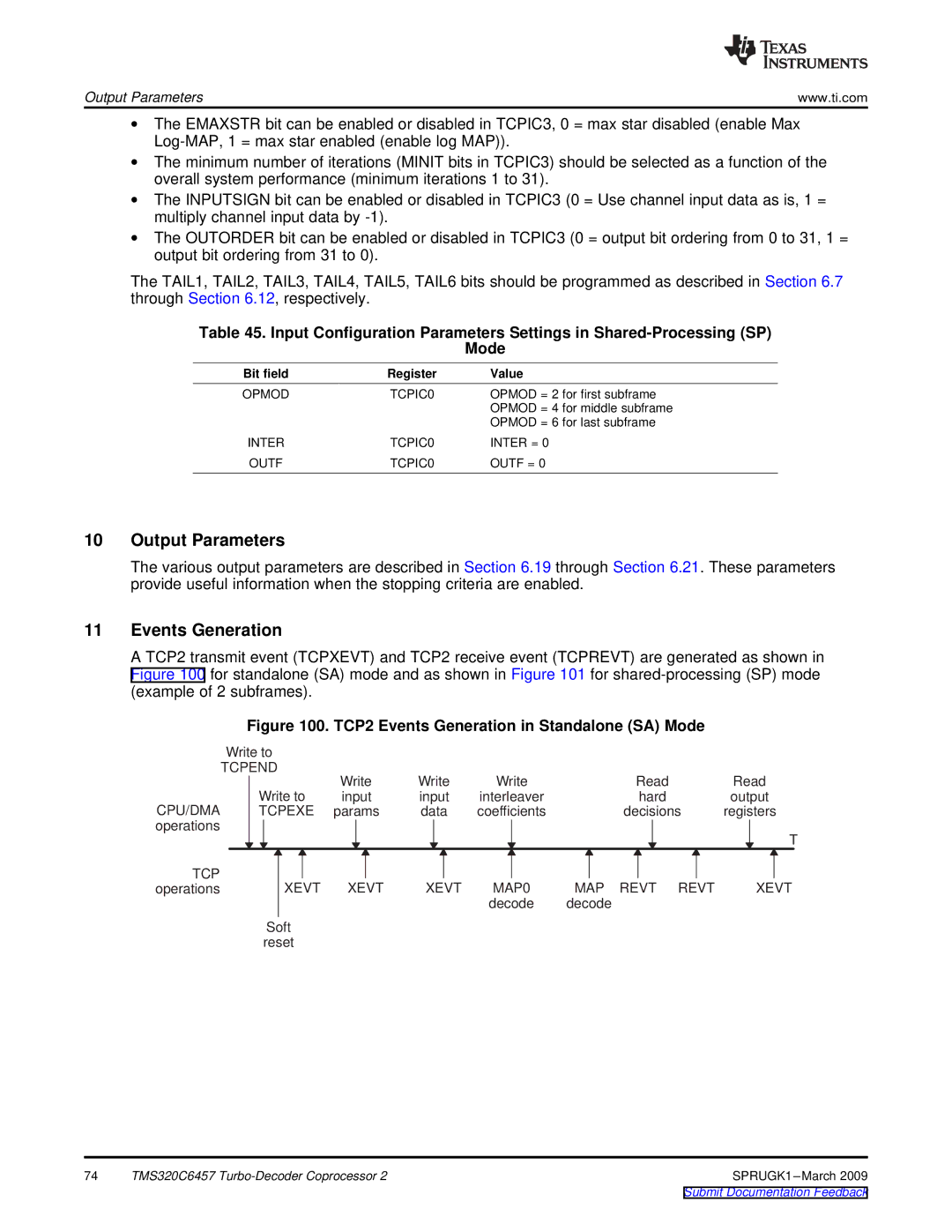
Output Parameters | www.ti.com |
∙The EMAXSTR bit can be enabled or disabled in TCPIC3, 0 = max star disabled (enable Max
∙The minimum number of iterations (MINIT bits in TCPIC3) should be selected as a function of the overall system performance (minimum iterations 1 to 31).
∙The INPUTSIGN bit can be enabled or disabled in TCPIC3 (0 = Use channel input data as is, 1 = multiply channel input data by
∙The OUTORDER bit can be enabled or disabled in TCPIC3 (0 = output bit ordering from 0 to 31, 1 = output bit ordering from 31 to 0).
The TAIL1, TAIL2, TAIL3, TAIL4, TAIL5, TAIL6 bits should be programmed as described in Section 6.7 through Section 6.12, respectively.
Table 45. Input Configuration Parameters Settings in
Mode
Bit field | Register | Value |
OPMOD | TCPIC0 | OPMOD = 2 for first subframe |
|
| OPMOD = 4 for middle subframe |
|
| OPMOD = 6 for last subframe |
INTER | TCPIC0 | INTER = 0 |
OUTF | TCPIC0 | OUTF = 0 |
10Output Parameters
The various output parameters are described in Section 6.19 through Section 6.21. These parameters provide useful information when the stopping criteria are enabled.
11Events Generation
A TCP2 transmit event (TCPXEVT) and TCP2 receive event (TCPREVT) are generated as shown in Figure 100 for standalone (SA) mode and as shown in Figure 101 for
Figure 100. TCP2 Events Generation in Standalone (SA) Mode
| Write to |
|
|
|
|
|
|
|
|
|
|
|
|
|
|
|
|
| |||||
| TCPEND | Write | Write | Write |
| Read | Read | ||||||||||||||||
|
|
| Write to |
| |||||||||||||||||||
CPU/DMA |
|
| input | input | interleaver |
|
| hard | output | ||||||||||||||
|
| TCPEXE | params | data | coefficients |
| decisions | registers | |||||||||||||||
operations |
|
|
|
|
|
|
|
|
|
|
|
|
|
|
|
|
|
|
|
|
| T | |
|
|
|
|
|
|
|
|
|
|
|
|
|
|
|
|
|
|
|
|
| |||
|
|
|
|
|
|
|
|
|
|
|
|
|
|
|
|
|
|
|
|
|
| ||
TCP |
|
|
|
|
|
|
|
|
|
|
|
|
|
|
|
|
|
|
|
|
|
|
|
|
|
|
| XEVT | XEVT | XEVT | MAP0 | MAP REVT REVT |
| XEVT | |||||||||||||
operations |
|
|
|
|
| ||||||||||||||||||
|
|
|
|
|
|
|
|
|
|
|
|
| decode | decode |
|
|
|
| |||||
|
|
|
|
|
|
|
|
|
|
|
|
|
|
|
|
|
|
|
|
|
|
|
|
|
|
|
| Soft |
|
|
|
|
|
|
|
|
|
|
|
|
|
|
|
|
| ||
|
|
| reset |
|
|
|
|
|
|
|
|
|
|
|
|
|
|
|
|
| |||
74 | TMS320C6457 |
